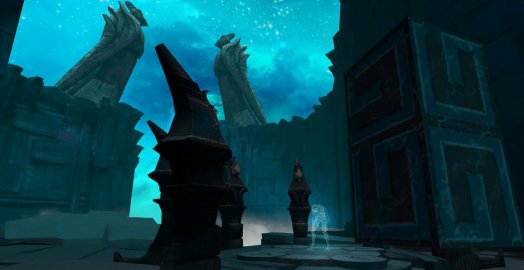Review for Eclipse: Edge of Light

Game information
With Eclipse: Edge of Light, developer White Elk has tapped into the ability of VR to let players explore exotic locations, in this case by taking on the role of a stranded spacefarer who must brave the alien architecture and terrain of an unknown planet. The platforming and puzzle-solving gameplay is basic without being banal, thanks in large part to some engaging visual design and the fact that boosting through virtual environments with a jetpack is a hoot, but for a rewarding narrative experience you’ll have to look elsewhere.
It only takes a few short moments for the game to throw you right into the action via a couple of disorienting fade-to-black transitions in which you first witness your ship crash-landing against a distant horizon, then materialize next to the craft as its sole passenger, then reappear in a rocky tunnel a short distance away. Here you pick up a mysterious orb, known as the Artifact, which will prove to have several uses throughout the journey to come. It’s a confusing collection of disconnected scenes, strung together without any further explanation, but it’s over almost before it’s begun, and it honestly matters little once the actual gameplay takes over.
Navigation in Eclipse is entirely free-roaming in first-person, making use of the protagonist’s equipped jetpack and the planet’s low gravity to boost and float over obstacles or from ledge to ledge. Doing this is quite fun, particularly in virtual reality. The jetpack boost only lasts for a few seconds, but recharges quickly, making the platforming equal parts horizontal and vertical.
The Artifact itself takes over the remaining gameplay interactions, utilized in different ways depending on the context. To kick your expedition off, a flick of the wrist (in my case with the PlayStation 4’s DualShock controller) sends the orb flying out of your on-screen hand and into the crashed vessel to dislodge it with a small explosion and open the path ahead. At other times, flinging the Artifact onto certain surfaces, with the orb doing a bit of self-course correcting to assist with finnicky VR aiming, morphs it into a platform that can then be used to gain access to the next ledge. Simple button presses draw the Artifact right back into the astronaut’s hand, ready to use again.
This multifaceted tool also has the ability to project a force field that lets you move heavy objects around and acts as a storage housing for dust gained by smashing small containers throughout the world. The latter is used to power some mechanical gating devices, though as a game mechanic it seems tacked on and rather superfluous, as there’s not even an on-screen indicator of how much dust has been collected or is needed at any given time.
One function the Artifact doesn’t serve is as a weapon, for the simple reason that there is no combat in Eclipse or enemies to worry about. Occasionally, however, a puzzle will involve a large statue that continuously scans the room and will blast you if it catches you, and the Artifact is indeed used to smash these statues if you can maneuver your way within striking distance of each one’s weak spot, its head. It is possible to die – for example, plunging to your death, disintegration, or being crushed – but this just pushes you back a few moments to the last checkpoint.
The planet is home to a species of benign cow-like beast that won’t bother you but will smash through certain obstacles if you trick it into doing so. The local flora – geometrically anomalous trees, plant-like digits probing out of the rocky terrain, and pods secreting spores that can power your jetpack mid-flight – can sometimes be scanned by tilting your visor’s viewfinder across them for a bit of flavor text.
The same thing goes for the last remnants left behind by the previous civilization, which serve to deliver what little there is of a plot, along with occasional visions in key locations that play out events of the past in a sort of visual recording. It seems the Artifact was created by the Prophet long ago to help save their race but ultimately aided him in destroying it after he became corrupted, and it’s his footsteps you’re ultimately following. This backstory is not explained in great detail, though, and seems fairly cookie-cutter in its simplicity.
The game’s charm lies far more in the varied 3D environments you get to explore, including the planet’s natural habitats but also a fair share of the previous civilization’s ruins, which were built at an imposingly large scale. Over the course of roughly four hours, you’ll venture through an admittedly clichéd temple, a trap-laden labyrinth, go on a boat ride down a canyon river, and make your way to a tall tower that’s been visible in the distance even from the game’s earliest moments for the final showdown.
The graphics aren’t flashy, reflecting the game’s mobile origins, and consist largely of rocky or earthen terrain in gray, brown, or sand-tone hues, but are dotted with artificial structures and machinery of unknown design which are interesting to stumble across. All of this is accompanied by a serene soundtrack of quiet tunes, generally mysterious and zen-like, well-suited for exploring such unfamiliar vistas. Sound effects are satisfyingly loud and crisp, from the boost and hiss of your jetpack discharging and exhausting itself, to the shattering of containers as the Artifact impacts them. With the exception of the aforementioned bovine creatures, the planet seems to be largely devoid of fauna, and therefore offers precious little in terms of ambient sound.
The developers have thoughtfully included a welcome breadth of options to tune your VR experience, including multiple movement settings. Though the “smooth” turn setting made my stomach lurch almost immediately, there are several incremental turn settings to tailor the experience to your liking. A more restrictive helmet visor can also optionally be enabled, zeroing your peripheral vision to what’s right in front of you. There are enough settings included to make all types of VR gamers feel comfortable while playing. It’s even possible to eschew the VR experience altogether, in which case Eclipse plays like a standard first-person game, simplifying its VR controls slightly to work with both gamepad thumbsticks instead.
Eclipse: Edge of Light offers a setting that’s interesting enough on its own terms, and even more intriguing when getting to examine it up close and personal in virtual reality. The exploration itself is often a good time, as boosting through open air with your back-mounted jetpack is a blast. However, overall it falls a bit short because it doesn’t actually do much with the world it presents. The gameplay is never particularly deep and the attempts at narrative start off clumsy and feel, at best, a bit cursory. There’s not enough staying power here to be the next epic space adventure, but for an afternoon of simple VR fun, it’s certainly worthwhile.

























